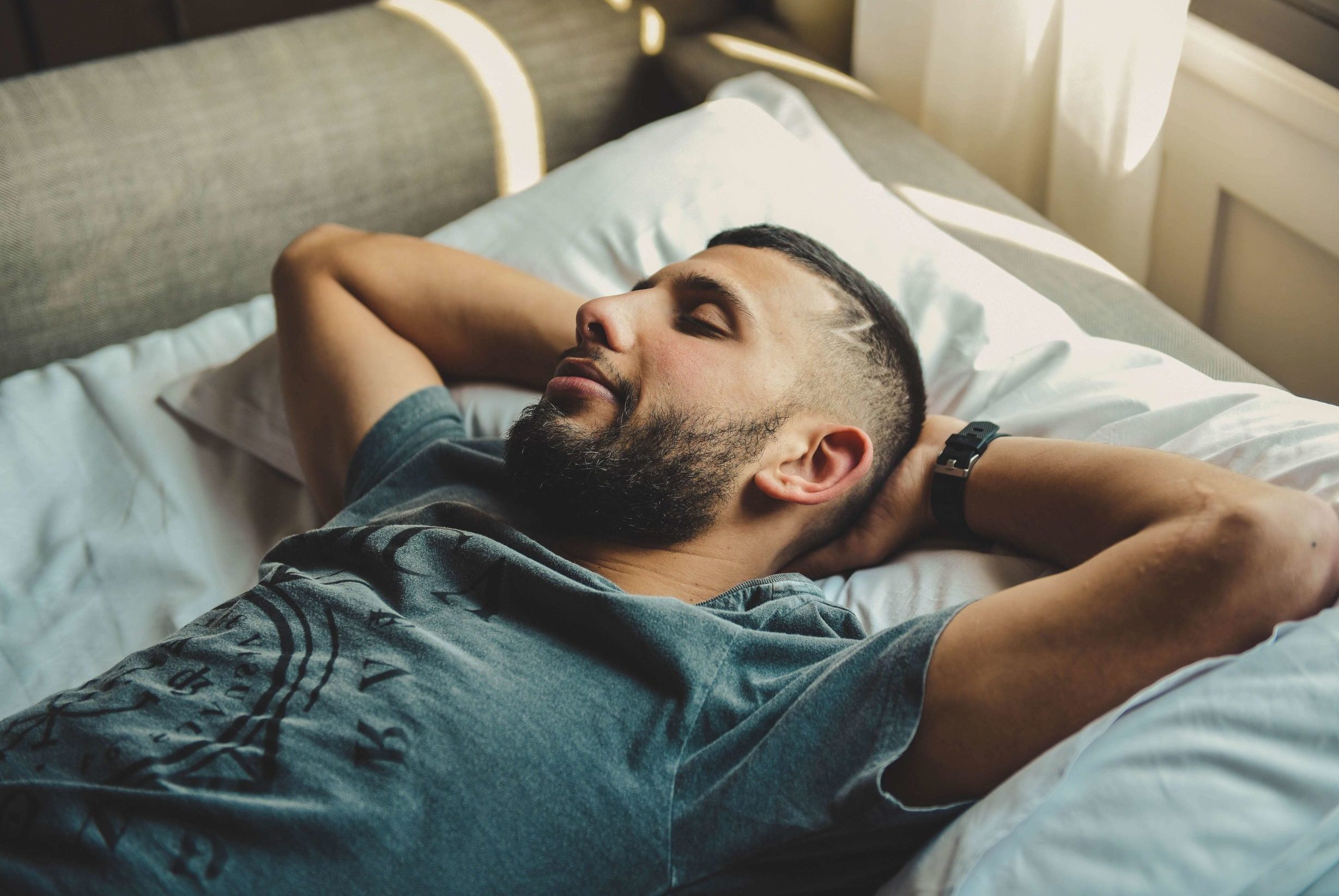Building muscle is a common goal among amongst all gym goers and fitness enthusiasts alike.
Any habit that can possible leverage the body’s ability to build muscle is usually of interest to anyone who works out.
One important component of building muscle and maximizing health is sleep.
Sleep is needed by the body but can also determine your levels of hormones, how well you recover from training, how mobile you are, and more.
The optimal amount of hours to sleep for recovery from training is around 7-9 hours per night. If you are younger, you should be sleeping in the range of 7-10 hours and if you’re older, you can sleep in the range of 6-9 hours every night.
Once you are sleeping within these ranges, a further way to possibly improve recovery and restfulness is to alternate the positions you sleep in.
Can Sleeping On the Floor Help To Build Muscle?
Sleeping on the floor is argued by many to be the more natural way to sleep and some swear by its positive effects.
While there are notable quality of life improvements that can be gained from sleeping on a flat surface, sleeping on the floor does not directly build muscle.
Obviously, the act of sleeping on the floor does not have significant hypertrophic effects and will not lead to elevated protein synthesis.
It is possible, however, that for some people, recovery after workouts will be improved.
Does Sleeping on the Floor Improve Muscle Recovery?
For some people who do not naturally move a large amount in their sleep, sleeping on the floor may improve muscle recovery after resistance training.
This is because when sleeping in a bed, you naturally move around less and do not change positions.
Beds conform to your body and sink in so that your weight is absorbed.
This means that you’re less likely to move during the night in your sleep since your position in bed is more “permanent” due to how beds become indented.
When you move around less, your blood flow can become impeded and muscles that need nourishment and oxygen may not get as much as they would otherwise.
Since to recover fully, muscles need nutrient rich blood and oxygen, sleeping in beds could potentially negatively affect muscle recovery.
The facts of whether or not sleeping on a floor can improve the results of resistance training have not yet been fully uncovered and there is limited scientific research available, so mostly anecdotal reports and deductive reasoning are used.
What Are the Benefits of Sleeping on the Floor?
These are all the benefits of sleeping on the floor. These benefits are based on both studies and anecdotal evidence.
- Better posture
- Improved spinal health
- Better circulation
- Healthier Joints
- Deeper sleep
- Enhanced cell hydration
- Increased flexibility
- Looser muscle fascia
Spinal Health and Posture
The benefits of better posture and spinal function are heavily supported by anecdotal evidence.
When sleeping on a mattress, the spine bends and unevenly sinks downwards during sleep.
These bends cause asymmetries in the spine and can worsen existing back issues and pain.
By sleeping on the floor, you avoid these problems and can mitigate any back pain or spinal dysfunction that would otherwise come about and worsen over time.
Better Joint Health, Flexibility, and Overall Wellness
Additional benefits to sleeping on the floor are better joint health, flexibility and wellness.
Regarding joints, flexibility, and general health, there has only been one study which looked at the differences between those who normally sleep on harder surfaces and those who sleep on beds.
This PubMed article advocates for more natural sleeping on harder surfaces without the use of pillows based on the data available.
The article looked at the health of forest dwellers and tribal people and compared it to that of people sleeping on beds.
It found that overall, people who did not sleep on beds had less musculoskeletal lesions, were less stiff, and had better joint health than those who slept on beds.
The logic for this is that our bodies have developed over time to sleep well on certain surfaces, namely the ground, and have not yet acclimatized to the soft, cushiony surfaces of beds.
Deeper Sleep, Circulation, and Recovery
Other benefits of sleeping on the floor are more restful sleep and improved blood flow.
A study done in 2018 found that sleeping on firmer mattress toppers resulted in deeper and more restorative sleep.
Deeper sleep correlates with many benefits, including better recovery from training, healthy sex hormone production, and efficient brain function.
If you sleep more deeply, you will have higher levels of testosterone and will be able to work out harder while recovering more quickly.
Cell Hydration, Sleep Mobility, and Fascia Tightness
Finally, the remaining benefits that sleeping on the floor has are cell hydration, mobility during sleeping, and the tightness of the muscle fascia (tissue that surrounds the muscle).
These are the least supported benefits of floor sleeping and are largely based on speculation as of now.
The idea is that by sleeping on the floor, your body will move around more and sleep more deeply while also pulling water out of your cells.
Once this water is pulled out of your cells, it signals to the body to move around which then can loosen the muscle fascia and ensure everything is working well and water is getting back into the cells, ultimately leading to overall improved cell hydration and more relaxed fascias around your muscles.
What Is the Best Sleeping Position To Build Muscle?
The best sleeping position to build muscle is on your back or on your left side.
These are the best sleeping positions because in both of these positions your neck is supported, your lungs are open, your heart is not strained, and your spine is kept even.
These sleeping positions will foster good circulation and recovery from workouts while making sure you sleep well and get rest.
Does Sleeping on the Floor Increase HGH Production?
One of the factors that is relevant for how much muscle you can build is the levels of HGH (human growth hormone) you produce.
HGH is mostly released during sleep.
HGH is released during sleep because sleep is the time that the body uses to recover, grow, and rebuild itself.
As of right now, there is not conclusive evidence to support whether or not sleeping on the floor can increase HGH production, however since sleeping on hard surfaces has been found to lead to deeper sleep, floor sleeping may have a positive effect on how much growth hormone your body produces.
Should You Sleep Without a Pillow?
Pillows are a relatively modern commodity that have risen into being the norm for every bed in the last several thousand years.
The positive or negative effects of sleeping without a pillow depends on the individual and their own sleeping habits.
If you sleep on your stomach or side, then sleeping with a pillow can potentially cause neck problems, however if you sleep on your back then a pillow will not cause any problems whatsoever.
For most people, using a pillow is fine and there is nothing to worry about from having an object to rest your head on during the night.
Is Sleeping on a Hard Surface Better?
According to the current research, sleeping on a hard surface is better than sleeping on a bed.
This is because hard surfaces do not “sink in” and cause uneven vertebrae in the spine and also help to promote deep sleep.
Hard surfaces cause the body to move more as well which may lead to improved cell hydration, looser muscle fascia, and better blood flow.
Summary
To summarize, the best positions to sleep in are on your back or on your left side.
Sleeping on the floor has several benefits and may improve recovery from training.
Based on available research, it is better to sleep on hard surfaces than beds but the extent of the benefits to doing so are not entirely known.
For more on sleep, building muscle, and cultivating lifestyle habits to gain better results from lifting, such as whether or not feeder workout training is effective and how to get a smaller waist as a man, click here.







